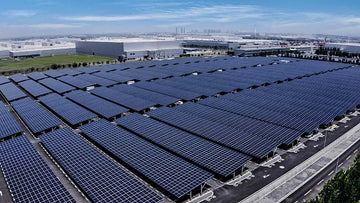Solar Panel Selection Guide
Power and efficiency:The power of a solar panel indicates the maximum power output it can produce, and the unit is usually watts (W). When choosing, you need to consider the actual power demand of the home or project to ensure that the selected panel can meet the power supply.
The efficiency index reflects the ability of a solar panel to convert solar energy into electricity. High efficiency panels can produce more electricity under the same conditions. It is recommended to choose products with an efficiency of 15% or more.
Material and type:
Material-wise, there are three main types of solar panels: monocrystalline silicon, polycrystalline silicon and amorphous silicon. Monocrystalline silicon panels have the highest efficiency but are more expensive; polycrystalline silicon panels are moderately priced and slightly less efficient; amorphous silicon panels are less expensive but have the lowest efficiency and shorter lifespan.
In terms of type, polycrystalline and monocrystalline panels are more common. Polycrystalline type is suitable for most application scenarios, while monocrystalline type is suitable for occasions with higher efficiency requirements.
Brand and quality:
Choosing products from well-known brands can ensure better after-sales service and product quality assurance.
Pay attention to whether the product has passed the relevant quality certification, such as CE certification, to ensure that the product meets the relevant standards and requirements.
Solar Cell Buying Guide
Battery type:Lithium-ion batteries are preferred for their high energy density, long life and lightweight.
Choose the right battery type according to the actual needs and budget.
Capacity and Voltage:
The capacity of the battery should be determined according to the system's electricity demand and energy storage needs. For general household, battery capacity between 50Ah~200Ah is more suitable.
The choice of voltage should be matched with other equipment in the system to ensure stable operation of the system.
Safety:
Choose products with safety features such as overcharge, overdischarge, overcurrent and short-circuit protection to ensure the safe use of the battery.
Inverter Selection Guide
Power matching:The power of the inverter should match the total power of the solar panels. For home systems, usually choose string inverters with a power range between 1~30KW.
Conversion efficiency:
The higher the conversion efficiency of the inverter, the higher the overall efficiency of the system. It is recommended to choose a product with a conversion efficiency of 90% or more.
Type and Characteristics:
Choose the right type of inverter (e.g. power station type, string type, micro) according to the system requirements.
Pay attention to the output voltage adjustment performance, overall efficiency, starting performance and other key indicators of the inverter.
Brand and quality:
Choose products of well-known brands to ensure the quality and stability of the inverter.
Pay attention to the after-sales service and quality assurance of the product, and choose the brand with high reputation.
Solar Controller Buying Guide
Charging method:Choose the appropriate charging method (such as PWM controller or MPPT controller) according to the actual demand.PWM controller is suitable for small systems, while MPPT controller is suitable for large systems.
Capacity:
The capacity of the solar controller should be equal to or slightly larger than the capacity of the solar panel. The general capacity should be selected based on the rated current of the battery bank and allow for appropriate redundancy.
Functionality and Protection:
Pay attention to the functional configuration of the solar controller, such as charging control, discharging control, and system protection.
Make sure the product has safety features such as overcharge, overdischarge, overcurrent and short circuit protection.
Compatibility:
Ensure the compatibility of the solar controller with other devices in the system (e.g. batteries, inverters, etc.).

















